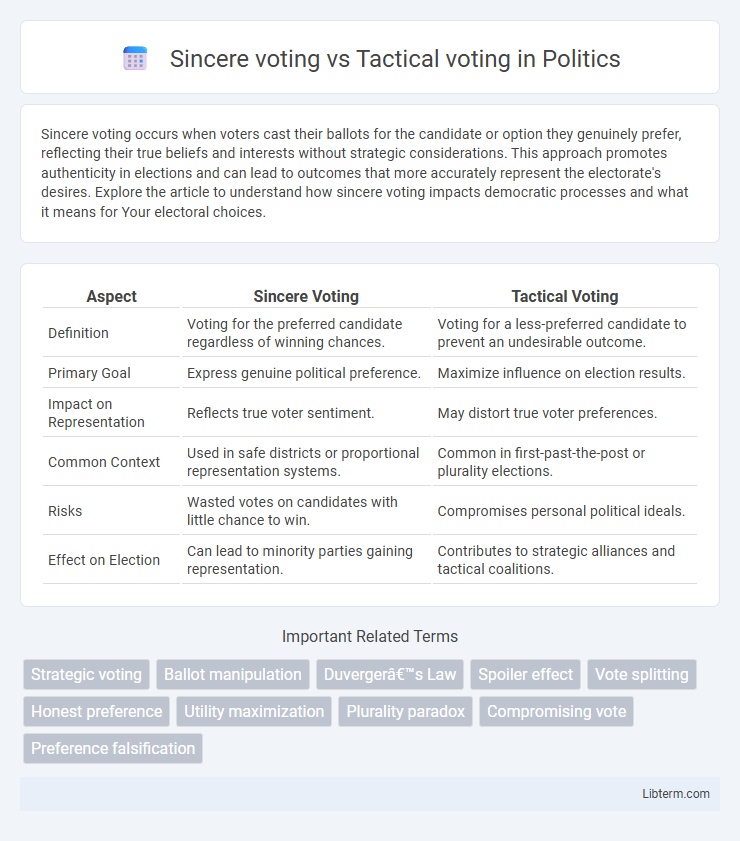Sincere voting occurs when voters cast their ballots for the candidate or option they genuinely prefer, reflecting their true beliefs and interests without strategic considerations. This approach promotes authenticity in elections and can lead to outcomes that more accurately represent the electorate's desires. Explore the article to understand how sincere voting impacts democratic processes and what it means for Your electoral choices.
Table of Comparison
| Aspect | Sincere Voting | Tactical Voting |
|---|---|---|
| Definition | Voting for the preferred candidate regardless of winning chances. | Voting for a less-preferred candidate to prevent an undesirable outcome. |
| Primary Goal | Express genuine political preference. | Maximize influence on election results. |
| Impact on Representation | Reflects true voter sentiment. | May distort true voter preferences. |
| Common Context | Used in safe districts or proportional representation systems. | Common in first-past-the-post or plurality elections. |
| Risks | Wasted votes on candidates with little chance to win. | Compromises personal political ideals. |
| Effect on Election | Can lead to minority parties gaining representation. | Contributes to strategic alliances and tactical coalitions. |
Understanding Sincere and Tactical Voting
Sincere voting involves casting a ballot for a candidate or party that aligns most closely with a voter's true preferences, reflecting genuine support without strategic considerations. Tactical voting occurs when voters select a less preferred but more viable candidate to prevent an undesirable outcome, often influenced by factors like polling data and election systems. Understanding the distinction between sincere and tactical voting is crucial for analyzing electoral behavior and its impact on election results and party strategies.
What is Sincere Voting?
Sincere voting refers to casting a ballot for a candidate or party that a voter genuinely prefers, reflecting their true political beliefs and policy priorities. This method prioritizes honest expression of individual preferences without strategic considerations about the likelihood of a candidate winning. Unlike tactical voting, sincere voting does not involve voting for a less-preferred but more viable candidate to influence election outcomes.
Defining Tactical Voting
Tactical voting involves casting a ballot not for a preferred candidate, but for one with a better chance of winning, aiming to prevent an undesirable outcome. This strategy contrasts with sincere voting, where voters select candidates that genuinely represent their preferences. Understanding tactical voting highlights how voters adapt strategies in plurality or first-past-the-post systems to influence election results more effectively.
Why Voters Choose Sincere Voting
Voters choose sincere voting to genuinely express their true preferences and support candidates who align with their values, ensuring their voice reflects authentic democratic participation. This approach fosters trust in the electoral process by emphasizing honesty over strategic manipulation, reducing voter cynicism. Sincere voting also aims to strengthen political representation by electing candidates based on voter conviction rather than calculated outcomes.
Motivations Behind Tactical Voting
Tactical voting is driven by the desire to influence election outcomes more effectively by supporting a candidate with a realistic chance of winning instead of one's true preference. Voters engage in tactical voting to prevent the least favored candidate from winning, often in closely contested races or under plurality voting systems. This behavior contrasts with sincere voting, where choices reflect genuine preferences without strategic considerations.
Impact of Sincere Voting on Election Outcomes
Sincere voting, where voters select their genuinely preferred candidate, often leads to election outcomes that more accurately reflect the electorate's true preferences, enhancing the legitimacy of democratic processes. This voting behavior can result in the election of candidates who represent the majority's authentic interests, avoiding distortions caused by strategic choices. While sincere voting may occasionally allow less viable candidates to influence results, it ultimately supports a more transparent and responsive political system by prioritizing honest voter expression.
Tactical Voting in Different Electoral Systems
Tactical voting varies significantly across electoral systems, as voters adjust strategies based on the system's mechanics to maximize their preferred outcome. In proportional representation systems, tactical voting often involves supporting smaller parties likely to pass electoral thresholds, whereas in first-past-the-post systems, voters tend to choose between major candidates to prevent least favored outcomes. Mixed electoral systems combine these dynamics, leading voters to engage in tactical voting both at district and party-list levels to influence overall representation.
Pros and Cons: Sincere vs Tactical Voting
Sincere voting reflects a voter's genuine preference, maximizing personal satisfaction and promoting ideological representation but can lead to wasted votes in systems with plurality or majoritarian rules. Tactical voting aims to influence election outcomes strategically by supporting less-preferred but more viable candidates, increasing the chance of defeating undesirable options but risking misrepresentation of true voter preferences. While sincere voting upholds electoral honesty, tactical voting enhances strategic impact, creating a trade-off between authenticity and effectiveness in vote casting.
Psychological Factors Influencing Voting Behavior
Psychological factors influencing voting behavior reveal that sincere voting aligns with voters' genuine preferences and intrinsic values, fostering cognitive consistency and emotional satisfaction. Tactical voting, driven by strategic considerations and fear of "wasting" votes, involves complex cognitive processes such as risk assessment and social influence. Voters often weigh perceived candidate viability and anticipated election outcomes, which can lead to cognitive dissonance and strategic compromise between idealism and pragmatism.
Strengthening Democracy: Encouraging Sincere Votes
Sincere voting strengthens democracy by promoting genuine representation of voter preferences, allowing elected officials to accurately reflect the electorate's true interests. Encouraging sincere votes reduces distortions caused by tactical voting, which often undermines the legitimacy of electoral outcomes. By fostering an environment where voters feel confident expressing their honest choices, democratic institutions gain greater accountability and public trust.
Sincere voting Infographic

 libterm.com
libterm.com